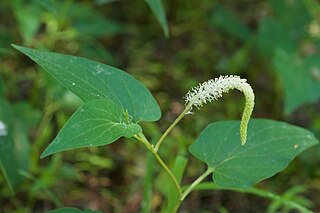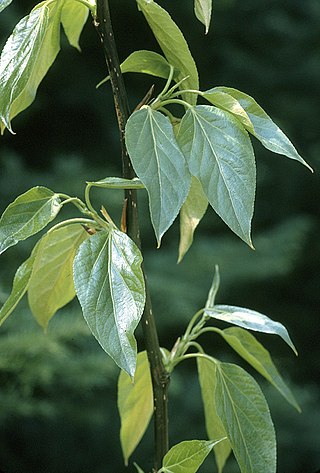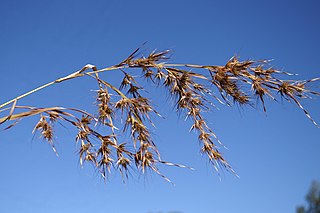
Quercus virginiana, also known as the southern live oak, is an evergreen oak tree endemic to the Southeastern United States. Though many other species are loosely called live oak, the southern live oak is particularly iconic of the Old South. Many very large and old specimens of live oak can be found today in the Deep South region of the United States.

Taxodium ascendens, also known as pond cypress, is a deciduous conifer of the genus Taxodium, native to North America. Many botanists treat it as a variety of bald cypress, Taxodium distichum rather than as a distinct species, but it differs in habitat, occurring mainly in still blackwater rivers, ponds and swamps without silt-rich flood deposits. It predominates in cypress dome habitats.

Taxodium distichum is a deciduous conifer in the family Cupressaceae. It is native to the southeastern United States. Hardy and tough, this tree adapts to a wide range of soil types, whether wet, salty, dry, or swampy. It is noted for the russet-red fall color of its lacy needles.

Saururus cernuus is a medicinal and ornamental plant native to eastern North America. It grows in wet areas or shallow water, and can be up to about a meter tall. The native range covers much of the eastern United States, as far west as eastern Texas and Kansas, south to Florida, and north to Michigan and New York state. Saururus cernuus also occurs in Ontario Canada. It is an obligate wetland plant and able to grow in saturated soils.

Quercus austrina, the bastard white oak or bluff oak, is an oak species that is endemic to the southeastern United States from Mississippi to the Carolinas, with a few isolated populations in Arkansas.

Populus balsamifera, commonly called balsam poplar, bam, bamtree, eastern balsam-poplar, hackmatack, tacamahac poplar, tacamahaca, is a tree species in the balsam poplar species group in the poplar genus, Populus. The genus name Populus is from the Latin for poplar, and the specific epithet balsamifera from Latin for "balsam-bearing".

Lonicera sempervirens is a flowering plant species of honeysuckle vine native to the eastern United States which is known for its reddish flowers.

Calamagrostis canadensis is a species of grass, having three or more varieties, in the family Poaceae. It is known variously by the common names of bluejoint, bluejoint reedgrass, marsh reedgrass, Canadian reedgrass, meadow pinegrass, Canada bluejoint and marsh pinegrass.
Paspalum repens, known as horsetail paspalum or water paspalum, is a species of grass native to South America, Central America, and North America. It is often called Paspalum fluitans, though this name is treated as a synonym of P. repens in Kew's Plants of the World Online database and the Flora of North America project. It is an obligate wetland species, often found submersed or floating in shallow water bodies or on the edges of rivers. It grows to be about a foot tall, with lance shaped leaves, spongy air-filled stems, and often a reddish tint. Inflorescence takes the form of spikelets.

Elaeagnus pungens is a species of flowering plant in the family Elaeagnaceae, known by the common names thorny olive, spiny oleaster and silverthorn; also by the family name "oleaster". It is native to Asia, including China and Japan. It is present in the southeastern United States as an introduced species, a common landscaping and ornamental plant, and sometimes an invasive species.

Hydrolea ovata is a species of flowering plant known by the common names ovate false fiddleleaf and blue waterleaf. It is native to the southeastern United States.

Themeda quadrivalvis is a species of grass known by the common names grader grass, habana grass, and kangaroo grass, not to be confused with Themeda triandra, which is also known as kangaroo grass. It is native to India, Nepal, and Malaysia. It can also be found in many other places as an introduced species and often a noxious weed. It occurs in the United States, New Caledonia, Fiji, Mauritius, Thailand, Indonesia, Papua New Guinea, China, the Middle East and tropical America. It is a troublesome exotic weed in Australia, especially in northern regions. It is also an agricultural weed in crops such as sugar cane and lucerne.

Hydrolea is the only genus of the family Hydroleaceae of the order Solanales.

Yucca aloifolia is the type species for the genus Yucca. Common names include aloe yucca, dagger plant, and Spanish bayonet. It grows in sandy soils, especially on sand dunes along the coast.
Smilax pumila, the sarsaparilla vine, is a North American species of plants native to the southeastern United States from eastern Texas to South Carolina.

Quercus myrtifolia, the myrtle oak, is a North American species of oak. It is native to the southeastern United States. It is often found in coastal areas on sandy soils.

Hypericum frondosum, the cedarglade St. Johnswort or golden St. John's wort, is a species of flowering plant in the St. John's wort family, Hypericaceae. It is native to the central and southeastern United States in dry, rocky habitats.

Hypericum fasciculatum, known as peelbark St. Johnswort or sandweed, is a species of flowering plant in the St. Johnswort family, Hypericaceae, native to the southeastern United States. It is found from eastern North Carolina, south to southern Florida, west to eastern Louisiana. Kew's Plants of the World Online database also notes that it occurs in Cuba, though Cuba is not listed in several other sources. It was first described in 1797 by Jean-Baptiste Lamarck.

Mimosa quadrivalvis, known as fourvalve mimosa, sensitive briar and cat's claw, is a trailing vine native to North America, Central America, and the Caribbean. It is known as sensitive briar because the leaves fold when they are touched or disturbed.

















